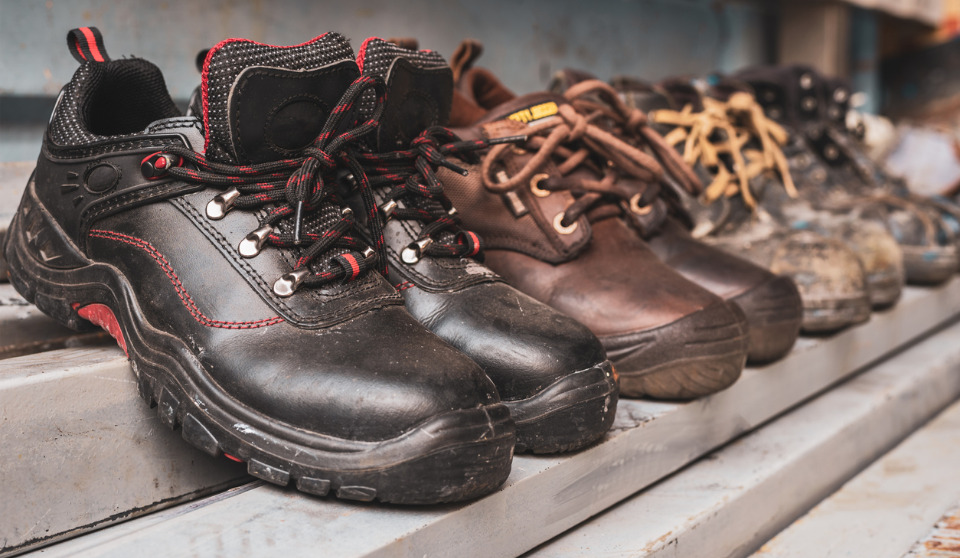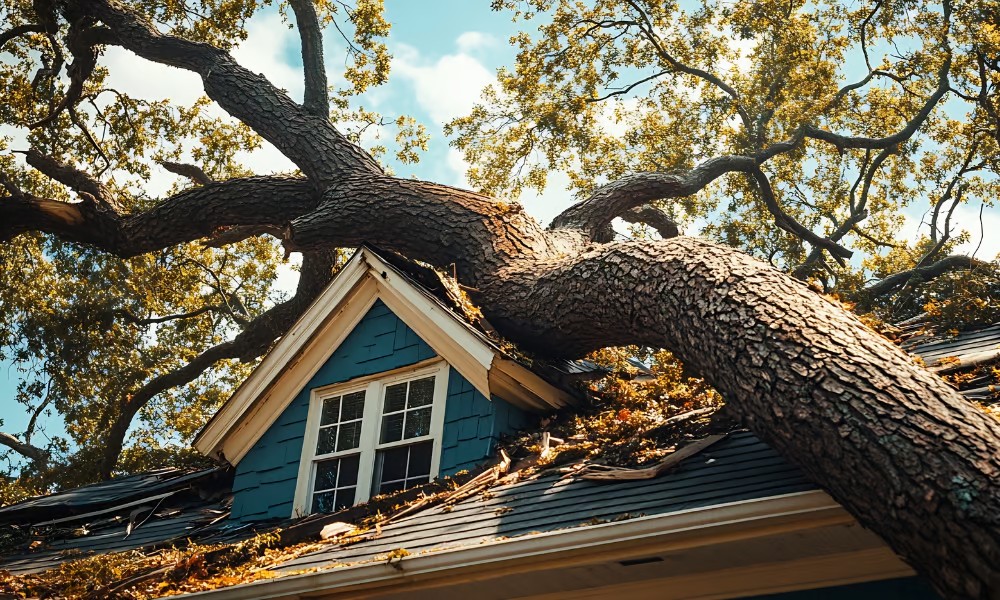Knowing when workers need foot protection and how to select the best boots for a job can help avoid serious foot injuries

Safety footwear is getting more technically advanced, and there are ever more types on the market. Yet, making sure workers have the footwear best suited to their task is still essential.
1. Who needs to wear safety shoes?
If a hazard assessment shows that foot hazards are present in the workplace, workers will need to wear safety footwear. Protective shoes are generally required in heavy industries — such as oil and gas, construction, mining, forestry, factories and mills — but also in light manufacturing companies and distribution warehouses, where forklifts and falling objects are hazards.
Workers who may not face constant risk of foot injuries are often now required to wear safety footwear, too, says Graeme Hill, owner and operator of Calgary-based Reddhart Workwear Stores. The requirement for safety footwear has in recent years been extended to workers in a wider range of professions.
“Over the last couple of decades, the type of industry or environment in which you’re now required to wear them has been broadening. In the past, salespeople working in the office and who occasionally went onto the shop floor would wear their regular shoes. But regulations have tightened up, and they’re now mandated to have a pair of safety footwear on if they go onto the shop floor,” he says.
2. When exactly are they required?
Safety footwear protects workers’ feet and legs against a variety of crush, puncture, chemical and burn injuries. These injuries result from hazards including: heavy objects falling, dropping or rolling onto feet; sharp objects that can cut the top of feet; materials, such as nails, that can penetrate bottoms or sides of feet; hot, corrosive or poisonous substances; splatters from welding, molten metal; chemicals; electrical hazards; static electrical discharges; and slips and trips caused by hazardous walking surfaces and environmental conditions, including uneven terrain, slippery surfaces and extreme temperatures.
Safety boots, made chiefly of leather, help protect against these hazards because they include elements such as protective toecap; metatarsal guard (which protects the top side of the foot) and protective sole plate (a metallic or non-metallic component that provides puncture protection to the sole of the foot). High-cut boots provide support against ankle injury.
3. What is the CSA standard for safety shoes, and do I have to follow it?
Occupational health and safety regulations in most jurisdictions in Canada require that safety footwear meet the requirements of CSA Z195:14 Protective Footwear. The standard, reaffirmed in 2019, includes design and performance requirements for protective footwear, including requirements for toe impact protection, sole puncture protection, metatarsal protection, electric-shock-resistant and slip-resistant soles, as well as for static-dissipative footwear and for slip-resisting footwear.
Andrew Violi, president of Toronto-based Mellow Walk Footwear and chairman of the Z195 technical committee, says the standard provides employers and safety managers with information on protective footwear that meets a very high bar for safety.
“From a manufacturer’s standpoint, it ensures that that we commonly agree on the criteria that the finished footwear must comply with. Today, footwear is made all over the world, so having common standards helps us create that shared responsibility to uphold quality and uniformity.”
Another standard, CSA Z195.1:16 Guideline for selection, care and use of protective footwear provides advice to employers on how to establish and maintain a safety footwear program and shows how to properly select, maintain and dispose of footwear. It also provides a guide for the assessment of risk factors and a hazard assessment worksheet.
A third related standard is the CSA Z334:14 (R2019) Over-the-shoe toe protectors. This discusses design and performance requirements for toe protectors intended to be worn over non-safety footwear.
4. How should safety footwear be selected?
All workplaces should complete a hazard assessment of the job and environment to identify the level and type of footwear protection that workers require. The basic safety boot provides impact and puncture resistance, but boots will often need to protect against additional, specific hazards.
Moreover, some employers will have their own particular requirements, says Terry White, safety manager at Fredericton, N.B.-based Eastern Construction Safety. “Some places want workers to have footwear of a certain height, for extra support around the ankle. Other employers want workers to have laces because they feel laces are better in the event a worker is injured. Medical people can just cut the laces and remove the boot from the foot more easily.”
Other criteria may arise from incident history, he adds. From an incident investigation, employers may have concluded an injury might have been prevented if the worker had been wearing a different pair of boots. “They’ve had people who have been injured, and to prevent that from recurring, they say this time we need a metatarsal guard on the boot.”
Look for the CSA marking that appears on every pair of CSA-certified footwear, which indicates the specific type of protection the boot provides and for which it has been certified. These markings, or symbols, are explained in the CSA 195-14:
- Green triangle: indicates sole puncture protection with a Grade 1 protective toecap. (Heavy industrial work: construction, machine shops where sharp objects are present.)
- Yellow triangle: indicates sole puncture protection with a Grade 2 protective toe. (Light industrial work.)
- Blue rectangle: indicates a Grade 1 protective toecap with no puncture-resistant sole. (Industrial work not requiring puncture protection.)
- Grey rectangle: indicates a Grade 2 protective toecap with no puncture-resistant sole. (Industrial and non-industrial work not requiring puncture protection.)
- White rectangle with orange omega: indicates electric-shock protective footwear. (Industrial work where contact with live electoral conductors can occur.)
- Yellow rectangle with black “SD”: indicates static-dissipative footwear. (Industrial work where a static discharge can create a hazard for workers or equipment.)
- Yellow rectangle with “SD” and plus sign: indicates super-static dissipative footwear and sole puncture protection with a Grade 2 protective toecap. (Industrial work where a static discharge can create a hazard for workers or equipment.)
- Red rectangle with white “C”: indicates electrically conductive footwear. (Industrial work where low-power electrical charges can create a hazard for workers or equipment.)
- Dark grey rectangle with “M”: indicates metatarsal protection. (Industrial work where heavy objects can hurt the foot’s metatarsal region.)
- White label with green fir tree: indicates protection when using chainsaws. (Forestry workers and others who work with or around hand-held chainsaws and other cutting tools.)
- Slip-resistance: Slip-resistance footwear has a marking indicating level of slip resistance on the packaging, a label on the footwear or on a product sheet.
Two grades of toe impact resistance are referred to in these markings, Violi says. “Grade 1 is the highest level of toe impact protection: The toecap is designed to withstand 125 joules of energy. Grade 2 is a lesser standard: The toecap can withstand 90 joules of energy.”
“But, today, what you find is that all manufacturers have gravitated to the highest level of protection, so it’s unusual today to find a Grade 2 toecap on the market,” he adds.
The high visibility of the markings makes them useful for safety managers, Violi says, allowing them to see at a glance whether a worker is wearing the shoes that have been selected for that workplace.
5. Who pays for it?
Safety boots can range from less than $100 to more than $300. Whether the employer or the worker pays for them and how much a worker pays depends on the company, White says.
In unionized workplaces, workers will often get an annual subsidy to cover the cost of protective equipment including footwear. “Through a collective bargaining agreement with their workers, the employers give them the amount they’re entitled to. It’s sometimes called a boot fund. They will give them maybe $250 for a pair of safety footwear for the year.”
Some employers, without an agreement, will give their workers a certain amount for boots. Others may negotiate purchasing agreements with safety supply stores that provide workers with a discount.
Then there are companies that require workers to pay the full price of the boots. “They make the purchase of the boots a condition of employment; if you’re going to work here, you have to come to work with a pair of safety footwear. The companies don’t buy them,” White says.
6. How should safety boots fit?
Boots should fit properly and be comfortable. For proper fit, the foot must be measured, Hill says. There should be enough room for the toes to move freely.
“You want your toes to be able to wiggle around freely, not touching the cap. Yet, you also want the rest of the boot to fit snugly. Snugly is the word we like to use, not tight but snug. As you wear the boots, over the first couple of weeks, the inside lining and the boot tend to mould to your own feet, and the boots will become more comfortable.”
Because feet swell during the day, the best time for fitting shoes is midday. Always allow space for work socks or arch supports. The user should walk in and flex the footwear to ensure a proper fit. Price is generally indicative of quality: The higher the cost, the better the fit and comfort are likely to be.
7. Do safety shoes expire?
There is no expiry date on safety boots. The lifespan of boots will primarily be determined by the worksite: Someone working around harsh chemicals, for example, will find their boots break down quickly.
When safety boots are getting worn, the bottoms start to get smooth; the inside linings break down (in part due to sweat); the leather develops cracks. Damaged footwear should be repaired or replaced.
Owners should inspect their safety boots regularly, White says. “Look at the soles to see if they are worn or have cracks. That’s a cause of concern because they won’t be able to grip a surface as well. Also, look at the condition of the material. It can’t be worn. There can’t be holes in them on the sides, such as cracks and cuts — wear and tear like that. And the material over the toe part has to be covering the toe. It can’t be worn and bare.”
8. Do visitors need to wear safety shoes?
Where a hazard assessment has established that safety boots need to be worn in a work site, then the footwear must be worn even for brief visits into the area. For example, politicians or VIPs attending a publicity event at such a work site need to put on safety shoes. If safety footwear is provided for occasional use, these must be cleaned and sanitized before offered to the next wearer.
9. Can safety shoes damage your feet?
Safety shoes sometimes cause problems for workers’ feet. These difficulties usually occur when the shoes are poor quality or were incorrectly fitted in the first place, Hill says.
“If boots are too tight and toes are touching a steel toecap, it will be extremely painful, and the wearer may get cuts or corns. If the boots are too big, the worker will be flopping around in them; the boots will not provide proper support, and the worker may be more vulnerable to twisting an ankle,” he says.
“A badly fitting pair of boots can put your skeleton structure a bit out of balance and that can contribute to back and knee pain over the long term.”
Violi says safety footwear is constantly evolving. Manufacturers are finding new ways to make the shoes easier on the feet.
“Different compounds are being used to make shoes lighter and more comfortable. There’s more cushioning support, better slip resistance. Instead of using steel, safety shoes often use composite materials such as non-steel toe caps or woven puncture-resistant sole plates,” he says.
“It’s not just about meeting the CSA standards, it’s also about giving the wearer a better-fitting and more comfortable safety shoe, a shoe that you can wear eight to 10 hours a day, five days a week and not feel fatigued in.”
10. What needs to be done to take care of them?
Applying a wax, oil or spray coating to footwear will make them water-resistant and help them last longer, says Hill. “Workers should condition the leather on a regular basis to keep it softer and supple. And let the boots air out each night, so the moisture that’s built up during the day can dry out overnight. That increases the lifespan of the insides.”
Following the manufacturer’s instructions for proper storage, cleaning and care will help workers maintain the effectiveness and extend the lifespan of their safety boots.





